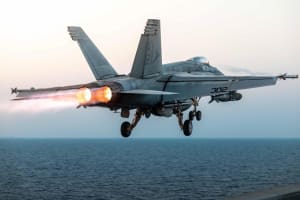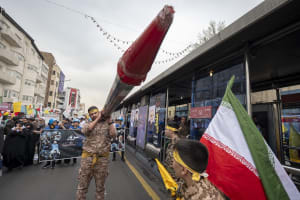IDF: We intercepted 11 out of 16 drones attacking Israel’s north over past 72 hours
IDF faces criticism after increasing numbers of drones infiltrate Israeli airspace

After northern Israel experienced the most intense phase of fighting since Oct. 8 over the past few days, the Israel Defense Forces said it managed to shoot down 11 out of 16, or 69%, of Hezbollah drones over the past 72 hours.
This is a much lower percentage compared to the number of rockets the aerial defense system can intercept, underlining the challenges the IDF has to face in the war against the Lebanese terror group.
“During the last 72 hours, the terrorist organization Hezbollah launched 16 hostile aircraft towards Israeli territory. Of these, the air defense systems and fighter jets successfully intercepted 11 hostile aircraft,” the IDF stated.
במהלך 72 השעות האחרונות, ארגון הטרור חיזבאללה שיגר 16 כלי טיס עוינים לעבר שטח ישראל.
— צבא ההגנה לישראל (@idfonline) June 14, 2024
מתוכם, מערכות ההגנה האווירית ומטוסי הקרב יירטו 11 כלי טיס עוינים בהצלחה>> pic.twitter.com/W7pE6y8zvM
The Israeli military has faced criticism in recent weeks after an increasing number of drones managed to infiltrate Israeli airspace, with several flying deep into the country, causing numerous casualties.
Earlier this week, a military source told Army Radio, “The drones are a threat that has no magic solutions, the response is far from hermetic.”
The drones’ small radar signature, low speed, and high maneuverability – all at a low production cost – have posed an unprecedented challenge to the IDF’s aerial defense system.
Additionally, local factors in the border area work to Hezbollah's advantage. Unlike during Iran’s massive drone attack in April, when the IDF had hours to prepare a response, the troops often only have seconds to minutes to react when a drone is launched from Lebanon.
Moreover, the hilly topography of the Galilee, which stretches over some 120 km (75 miles) along the border, allows Hezbollah to launch its drones in hidden areas and fly them low to the ground until they emerge on the Israeli side of the border, ready to strike a nearby town.
Moreover, once a drone is detected, the IDF still must verify that it isn’t a civilian aircraft or a "friendly" drone, costing the Israeli army even more time.
Despite the many challenges, the IDF stressed that it has been preparing to deal with the threat for many years.
The military is working on the return of “Vulcan” self-propelled anti-aircraft guns, which were retired from service in 2006. These Vulcans fire volleys of shells at hostile targets, instead of the more modern but expensive systems, like the Iron Dome, to launch guided missiles to intercept targets.
While it continues to work on other possible solutions, the IDF emphasized that there was no magic solution to the drone threat, especially if the enemy launched large drone “swarms.”
For the past decade, Israel has worked tirelessly on an initiative dubbed the "war between wars," aiming to thwart covert arms smuggling operations to Hezbollah, orchestrated by Iran’s Islamic Revolutionary Guard Corps (IRGC) via Iraq and Syria.
It is estimated that Hezbollah has amassed a huge arsenal of weapons, including some 150,000 rockets and missiles, as well as an estimated 2,000 drones of various types and ranges.

The All Israel News Staff is a team of journalists in Israel.
You might also like to read this:















